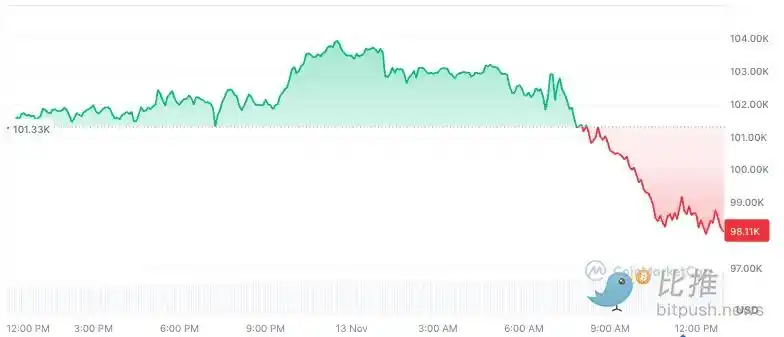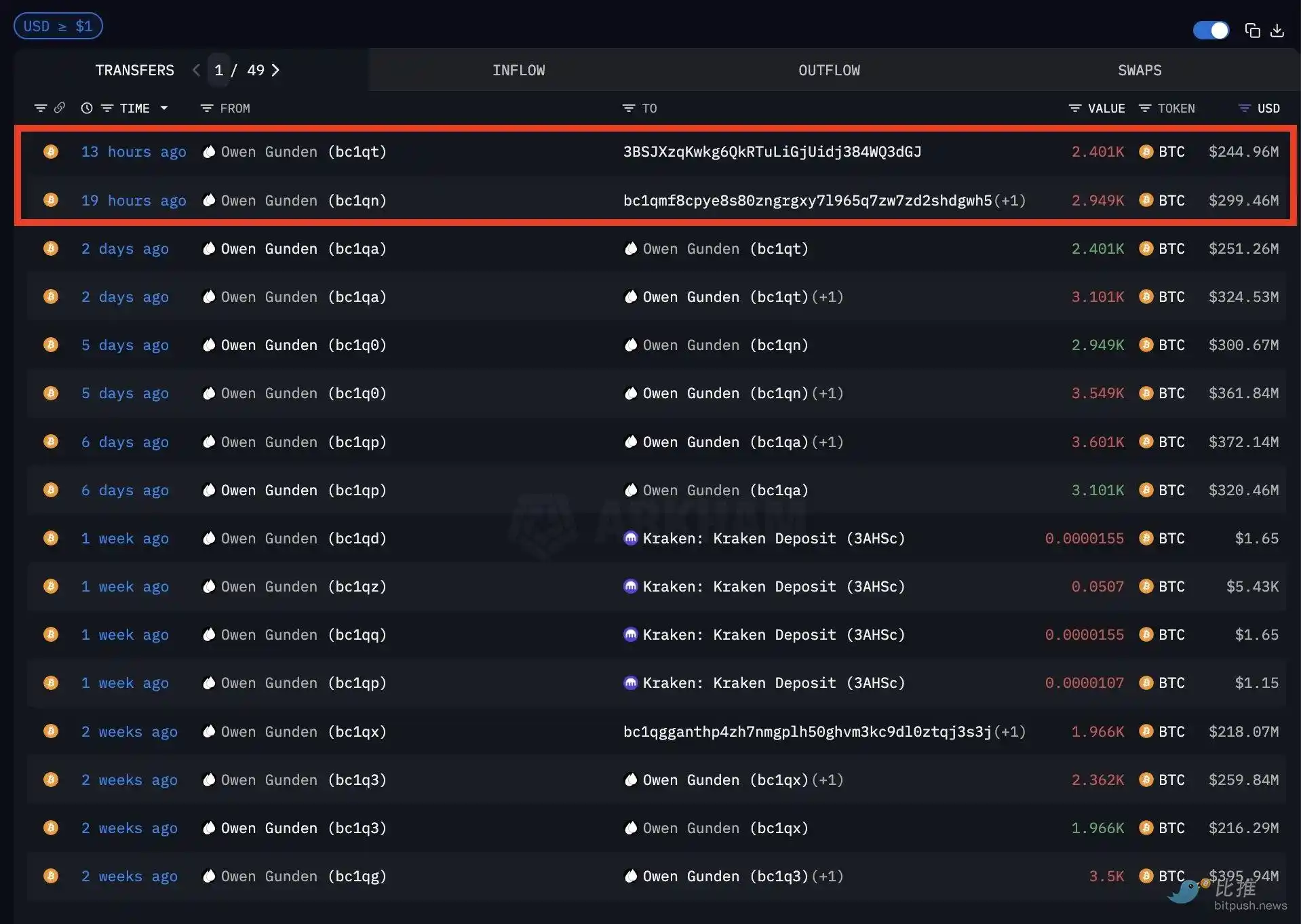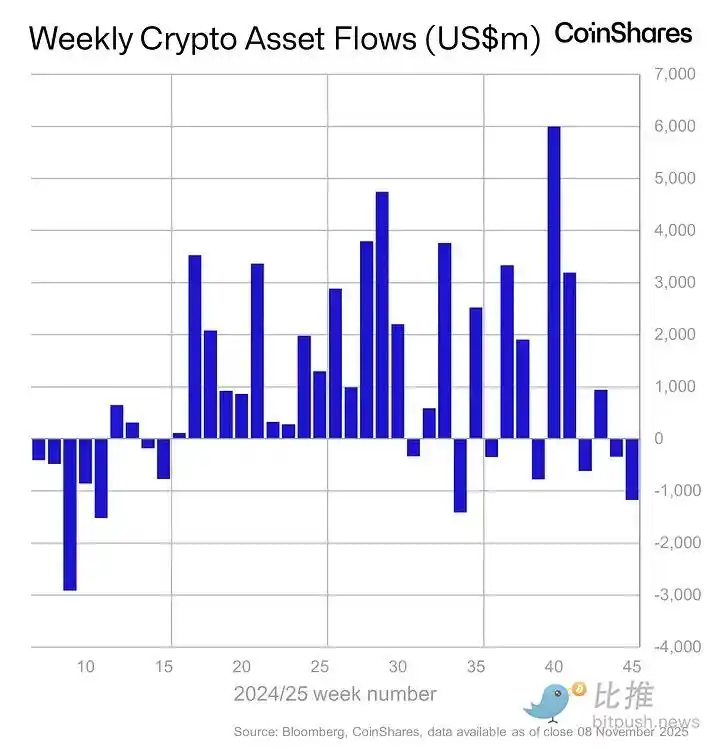Original Title: "Bitcoin Drops Back to 98,244, Is a Year-End Surge Out of the Question?"
Original Author: Bootly, bitpush news
The U.S. government shutdown has officially come to an end, but the capital markets have not seen a rebound.
On Thursday, local time, all three major U.S. stock indices fell sharply, with the Nasdaq down more than 2% and the S&P 500 closing down 1.3%; gold has lost key support levels.
Bitcoin has also suffered a heavy blow, dropping to a low of $98,244 by the close of U.S. markets, the lowest point since early May, marking the third time this month that Bitcoin has fallen below the $100,000 mark.

Market sentiment has slid from high levels, returning to the "extreme fear" zone.
This long-awaited "government resumption" has not alleviated the structural pressures in the market:
Tightening liquidity, concentrated selling by long-term holders, continuous outflows from ETFs, and rapidly cooling interest rate cut expectations.
U.S. Markets Become the "Main Force" Behind Bitcoin's Plunge: Sudden Drop in Risk Appetite + Liquidity Tightening Resonance
Bitcoin briefly rebounded to around $104,000 during Asian trading but quickly weakened as U.S. trading began, plunging below $100,000 in the afternoon, hitting a low of $98,000.
This trend is highly consistent with the simultaneous decline of tech stocks in the U.S.:
- Nasdaq plummets
- Crypto-related stocks like Coinbase and Robinhood decline
- Mining stocks lead the drop, with Bitdeer plummeting 19%, Bitfarms down 13%, and several mining companies falling over 10%
The fundamental reason is:
Rapid cooling of interest rate cut expectations → Comprehensive sell-off of risk assets.
Last week, the market believed there was an 85% chance of a rate cut in December;
Now, FedWatch shows only 66.9% remaining.
The future of "cheap money" is no longer certain, making it difficult for Bitcoin's valuation to hold.
At the same time, the U.S. fiscal side is also withdrawing liquidity.
During the government shutdown, the federal budget recorded a surplus of about $19.8 billion, and due to the large-scale shutdown, the surplus in October could be even higher. This means the government has temporarily reduced its "blood transfusion" to the market.
Analyst Mel Mattison described it as: "This is the driest fiscal liquidity environment in months or even years."
With fiscal tightening and cooling monetary conditions, the U.S. market has become the dominant force behind this round of Bitcoin's plunge.
However, Mattison also pointed out that fiscal tightening is only a short-term phenomenon: "The fiscal floodgates are about to reopen, and the Trump administration must increase stimulus before the midterm elections."
On-Chain Selling Pressure Concentrated Release: LTH Profit-Taking Combined with Whale Selling, Forming Resonance Downward
This round of Bitcoin dropping below $100,000 is not caused by retail panic, but rather a typical structural adjustment of synchronized reduction in on-chain medium to long-term funds.
CryptoQuant data shows that over the past 30 days, long-term holders (LTH) have sold a total of about 815,000 BTC, marking the highest sell-off scale since January 2024. On November 7, approximately $3 billion worth of Bitcoin profit-taking sales occurred on-chain, indicating that a large number of low-cost chips chose to cash out at this price level. Similar scales of profit-taking pressure have appeared during the mid-stages of the bull markets in 2020 and 2021, often corresponding to phase adjustment windows.

At the same time, whale activity has significantly increased, accelerating the downward pressure.

Arkham tracked:
- Early BTC whale Owen Gunden sold about $290 million BTC in one day, still holding $250 million in assets;
- A Satoshi-era whale holding coins for nearly 15 years cleared out about $1.5 billion last week;
- The large address 195DJ also sold a total of 13,004 BTC in October and continued to transfer chips to exchanges.

This means:
LTH profit-taking + whales concentrating their chip movements → Forming strong selling pressure in the short term.
ETF/ETP Funds Continue to Flow Out, U.S. Market Under Heaviest Pressure
According to a CoinShares report, global digital asset investment products have seen significant outflows for the second consecutive week, with a net outflow of $1.17 billion last week. Most of the outflows occurred in the U.S. market, with an outflow amounting to $1.22 billion, while the European market (Germany, Switzerland) still recorded a net inflow of about $90 million, showing a stark divergence.

Among them, Bitcoin and Ethereum are the "main battlegrounds" for this round of capital withdrawal:
- Bitcoin products saw a net outflow of $932 million
- Ethereum products saw a net outflow of $438 million
- During the same period, short Bitcoin products recorded a net inflow of $11.8 million, the highest level since May 2025
ETFs contributed significant upward momentum to Bitcoin in 2025, and when this buying pressure stagnates and turns into outflows, the price naturally comes under pressure.
Can We Still Sprint to New Highs This Year?
Bitcoin is currently hovering below the 365-day moving average. CryptoQuant views this as an important trend support level for this bull market: once it stands back above the average, the market is expected to strengthen again; if it continues to be under pressure, a mid-stage correction similar to September 2021 may occur.
The Fear and Greed Index has dropped to 15 (extreme fear), highly resembling the previous instances of "deep washout during mid-bull markets."
From the comprehensive signals of macro, on-chain, ETF, and technical structure, the possibility of breaking through the new high of $126,000 this year has significantly decreased.
Before the end of the year, Bitcoin is more likely to maintain a fluctuation between $95,000 and $110,000.
To break through strongly, three major conditions must be met:
- ETFs must resume continuous net inflows
- U.S. fiscal stimulus must be clearly implemented
- U.S. Treasury yields must decline, and dollar liquidity must improve
However, from the perspective of policy rhythm, these three are more likely to occur simultaneously in early 2026 rather than by the end of 2025.
Outlook for 2026: Liquidity and Cycles May Resonance
Despite short-term pressures, Bitcoin's medium to long-term trend remains solid.
2026 may even become the core year of this cycle.
1. Macroeconomic liquidity is expected to see a real turning point
As the economy slows and employment weakens, the probability of the Federal Reserve entering a substantial rate-cutting cycle in 2026-2027 is increasing.
2. ETF institutional expansion will bring larger-scale buying
In 2025, ETFs have validated the power of institutional buying.
Against the backdrop of a rate-cutting cycle, "long money" such as pensions, global asset management, and RIAs will enter deeply through ETFs, reshaping the valuation system.
3. 2026 is the "second year after halving": historically the strongest window
2013, 2017, 2021
All three cycles reached larger high points in the "second year after halving."
Based on this, our range judgment for 2026 is:
· Basic target: $160,000 – $240,000
· Strong scenario: $260,000 – $320,000
This round of decline resembles a deep washout in the mid-bull market rather than a trend reversal.
What will truly determine Bitcoin's next peak will be the resonance of macro and institutional funds in 2026.
免责声明:本文章仅代表作者个人观点,不代表本平台的立场和观点。本文章仅供信息分享,不构成对任何人的任何投资建议。用户与作者之间的任何争议,与本平台无关。如网页中刊载的文章或图片涉及侵权,请提供相关的权利证明和身份证明发送邮件到support@aicoin.com,本平台相关工作人员将会进行核查。




